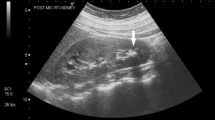Abstract
Summary
This report describes the clinical, biochemical and molecular data of a 78-year-old patient with xanthine dehydrogenase deficiency presenting as rheumatoid arthritis.
Background
Xanthinuria type I is a rare disorder of purine metabolism caused by xanthine dehydrogenase (XDH) deficiency; fewer than 150 cases have been described in the literature so far.
Methods
We describe the clinical history and urine and serum findings of a 78-year-old patient with isolated XDH deficiency presenting as rheumatoid arthritis. The diagnosis was confirmed by mutation analysis.
Results
The patient suffered from arthral symptoms and nephrocalcinosis. Very low concentrations of uric acid were observed in her serum and urine. The allopurinol loading test indicated her xanthinuria to be type I. Analysis of genomic DNA revealed novel heterozygous deletion in exon 8 (g.27073delC, p.214QfsX4) and previously published heterozygous nucleotide missense transition in exon 25 (g.64772-C>T, p.T910M).
Conclusion
Hereditary xanthinuria is a rare disorder, but it also needs to be considered in patients not originating from Mediterranean countries or the Near or Middle East. Urate concentration in serum and urine may provide an initial indication of XDH deficiency before high-performance liquid chromatography (HPLC) analysis is performed. The key to identifying the disorder is a greater awareness of XDH deficiency amongst primary care physicians, nephrologists, and urologists, but also rheumatologists. The diagnosis and therapeutic management requires a multidisciplinary approach.
Similar content being viewed by others
Abbreviations
- GC-MS:
-
gas chromatography–mass spectrometry
- HPLC:
-
high-performance liquid chromatography
- UA:
-
uric acid
- XDH:
-
xanthine dehydrogenase
References
Arikyants N, Sarkissian A, Hesse A, Eggermann T, Leumann E, Steinmann B (2007) Xanthinuria type I: a rare cause of urolithiasis. Pediatr Nephrol 22:310–314
Blake DR, Stevens CR, Sahinoglu T et al (1997) Xanthine oxidase: four roles for the enzyme in rheumatoid pathology. Biochem Soc Trans 25:812–816
Bradford MJ, Hrehorovich V (1969) Xanthinuria, psoriasis and arthritis. Am J Med 46:137–141
Engelman K, Watts RW, Klinenberg JR, Sjoerdsma A, Seegmiller JE (1966) Clinical physiological exercise and biochemical studies of a patient with xanthinuria and pheochromocytoma. Am J Med 37:836–861
Freudweiler M (1901) Experimentelle Untersuchungen uber die Entstchung der Gichtknoten. Deutches Arch Klin Med 69:155
Gok F, Ichida K, Topaloglu R (2003) Mutational analysis of the xanthine dehydrogenase gene in a Turkish family with autosomal recessive classical xanthinuria. Nephrol Dial Transplant 18:2278–2283
Ichida K, Yoshida M, Sakuma R, Hosoya T (1998) Two siblings with classical xanthinuria type I: significance of allopurinol loading test. Intern Med 37:77–82
Klocke R, Mani AR, Moore KP, Blake DR, Mapp PI (2005) Inactivation of xanthine oxidoreductase is associated with increased joint swelling and nitrotyrosine formation in acute antigen-induced arthritis. Clin Exp Rheumatol 23:345–350
Raivio KO, Saksela M, Lapatto R (2001) Xanthine oxidoreductase: role in human pathophysiology and in hereditary xanthinuria. In: Scriver CR, Beaudet AL, Sly WS, Valle D (eds) The metabolic and molecular bases of inherited diseases. McGraw-Hill, New York, pp 2639–2652
Shibutani Y, Ueo T, Yamamoto T, Takahashi S, Moriwaki Y, Higashino K (1999) A case of classical xanthinuria (type 1) with diabetes mellitus and Hashimoto’s thyroiditis. Clin Chim Acta 285:183–189
Acknowledgements
This study was supported by Research Project from the Ministry of Education, Youth and Sports of the Czech Republic, MSM 0021620806, by grant MZ0VFN2005 from the Ministry of Health of the Czech Republic and grant PB 1121/P01/2007/32 from the Polish Scientific Research Committee.
Author information
Authors and Affiliations
Corresponding author
Additional information
Communicated by: Georg Hoffmann
References to electronic databases:
Xanthine dehydrogenase deficiency (OMIM 278300, OMIM 603592), xanthine dehydrogenase (XDH, E.C. 1.1.1.204).
Agnieszka Jurecka and Blanka Stiburkova contributed equally to the study.
Rights and permissions
About this article
Cite this article
Jurecka, A., Stiburkova, B., Krijt, J. et al. Xanthine dehydrogenase deficiency with novel sequence variations presenting as rheumatoid arthritis in a 78-year-old patient. J Inherit Metab Dis 33 (Suppl 3), 21–24 (2010). https://doi.org/10.1007/s10545-009-9011-z
Received:
Revised:
Accepted:
Published:
Issue Date:
DOI: https://doi.org/10.1007/s10545-009-9011-z




